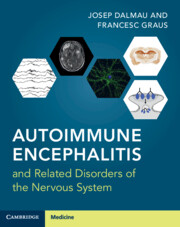Book contents
- Autoimmune Encephalitis and Related Disorders of the Nervous System
- Autoimmune Encephalitis and Related Disorders of the Nervous System
- Copyright page
- Dedication
- Contents
- Clinical Vignettes
- Videos
- Preface
- Abbreviations
- Section 1 Overview
- Section 2 Antibodies and Antigens
- Section 3 Specific Syndromes and Diseases
- Chapter 6 Limbic Encephalitis
- Chapter 7 Autoimmunity Against Proteins Associated with Voltage-Gated Potassium Channels
- Chapter 8 Anti-NMDAR Encephalitis
- Chapter 9 Seizures and Antibodies Against Surface Antigens
- Chapter 10 Acute Disseminated Encephalomyelitis and Myelin Oligodendrocyte Glycoprotein Antibody-Associated Disease
- Chapter 11 Neuromyelitis Optica Spectrum Disorders and Glial Fibrillary Acidic Protein Autoimmunity
- Chapter 12 Autoimmune Cerebellar Ataxias
- Chapter 13 Autoimmune Brainstem Encephalitis
- Chapter 14 Autoimmunity Against the Inhibitory Synapsis
- Chapter 15 Anti-IgLON5 Disease
- Chapter 16 Autoimmune and Inflammatory Encephalopathies as Complications of Cancer
- Chapter 17 Deconstructing Hashimoto Encephalopathy
- Chapter 18 CNS Syndromes at the Frontier of Autoimmune Encephalitis
- Section 4 Autoimmunity in Neurological and Psychiatric Diseases
- Index
- References
Chapter 12 - Autoimmune Cerebellar Ataxias
from Section 3 - Specific Syndromes and Diseases
Published online by Cambridge University Press: 27 January 2022
- Autoimmune Encephalitis and Related Disorders of the Nervous System
- Autoimmune Encephalitis and Related Disorders of the Nervous System
- Copyright page
- Dedication
- Contents
- Clinical Vignettes
- Videos
- Preface
- Abbreviations
- Section 1 Overview
- Section 2 Antibodies and Antigens
- Section 3 Specific Syndromes and Diseases
- Chapter 6 Limbic Encephalitis
- Chapter 7 Autoimmunity Against Proteins Associated with Voltage-Gated Potassium Channels
- Chapter 8 Anti-NMDAR Encephalitis
- Chapter 9 Seizures and Antibodies Against Surface Antigens
- Chapter 10 Acute Disseminated Encephalomyelitis and Myelin Oligodendrocyte Glycoprotein Antibody-Associated Disease
- Chapter 11 Neuromyelitis Optica Spectrum Disorders and Glial Fibrillary Acidic Protein Autoimmunity
- Chapter 12 Autoimmune Cerebellar Ataxias
- Chapter 13 Autoimmune Brainstem Encephalitis
- Chapter 14 Autoimmunity Against the Inhibitory Synapsis
- Chapter 15 Anti-IgLON5 Disease
- Chapter 16 Autoimmune and Inflammatory Encephalopathies as Complications of Cancer
- Chapter 17 Deconstructing Hashimoto Encephalopathy
- Chapter 18 CNS Syndromes at the Frontier of Autoimmune Encephalitis
- Section 4 Autoimmunity in Neurological and Psychiatric Diseases
- Index
- References
Summary
Autoimmune cerebellar ataxias include a heterogeneous group of disorders characterized by isolated or predominant cerebellar dysfunction caused by immune-mediated mechanisms. The best-characterized autoimmune ataxia is paraneoplastic cerebellar degeneration (PCD) that, depending on the type of cancer, associates with different paraneoplastic antibodies such as Yo antibodies in patients with breast or ovarian cancer, Tr (DNER) antibodies in patients with Hodgkin lymphoma, and SOX1 or voltage-gated calcium channel (VGCC) antibodies in patients with small-cell lung cancer (SCLC). Patients with PCD and SCLC can have concurrent symptoms of Lambert–Eaton myasthenic syndrome (LEMS). Non-paraneoplastic cerebellar ataxias usually associate with glutamic acid decarboxylase (GAD) or mGluR1 antibodies. Patients with autoimmune ataxia respond poorly to immunotherapy even when the associated antibodies are directed against neuronal surface antigens (VGCC, mGluR1). Cerebellar ataxia may occur in patients with dietary gluten sensitivity. The autoimmune pathogenesis of gluten ataxia is unclear. Acute cerebellar ataxia and acute cerebellitis are the most frequent causes of cerebellar dysfunction in children. Whereas the term acute cerebellar ataxia is used to define patients with normal MRI and a benign clinical course, the term acute cerebellitis implies a more severe disorder with MRI inflammatory changes. In these patients the long-term prognosis is less favourable.
Keywords
- Type
- Chapter
- Information
- Publisher: Cambridge University PressPrint publication year: 2022

